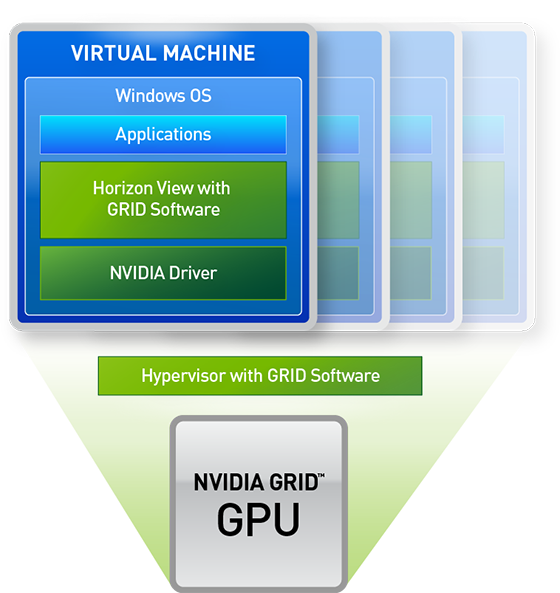Since we have stepped up storage by throwing SSD’s at the problem, we now are on to the next task of getting the best graphics experience to our end users. For too long people have relied on mammoth workstations with big graphics cards to get the job done. We have purchased several big time workstations to address our CAD and Modeling Teams. Doesn’t that fly in the face of Desktop Virtualization and consolidating all processes to the Datacenter. So the next logical step in the evolution of VDI is to virtualize 3D graphics.
Now that sounds like an easy task in this day and age of Apple’s motto of “it just works”, but imagine the time and dedication it took to create the first hypervisor. CPU and RAM are one thing, specific processing threads rendering graphics is very specific and takes time to perfect. VMware started with SVGA and Soft3D with View 5.0 and they have made major strides in graphics utilization. That being said VMware announced two exiting features in Horizon View 5.2, vSGA and vDGA. I will give a quick summary of both, but for more detailed information head over to Andre Leibovici’s Blog for a full breakdown of what they mean. Here is also the VMware White Paper of the complete line of Graphics Acceleration Deployment.
vSGA – Virtual Shared Graphics Acceleration
vSGA gives you the ability to provision multiple VM’s (Linked-Clones or Full VM’s) to single or multiple GPU’s. Graphics cards are presented to the VM as a software video driver and the graphics processes are handled by an ESXi driver (VIB). Graphics resources are reserved on a first come first serve basis so sizing and capacity is important to consider. You can also have various Pool types on a host and not all need graphics, this is important if you have various workstation classifications running in a cluster. vSGA is a great solution for users that require higher than normal graphics needs, rendering 1080p video, Open GL, DirectX, etc. We will get into configuring pools for vSGA but there are 3 options: Automatic, Software and Hardware.
vSGA Hardware Compatibility List
- GRID K1
- GRID K2
- Quadro 4000
- Quadro 5000
- Quadro 6000
- Tesla M2070Q
vDGA – Virtual Dedicated Graphics Acceleration
vDGA differs from vSGA in that the Physical GPU is assigned to the VM using DirectPath I/O so the full GPU is assigned to a specific machine. vSGA allows multiple VM’s to provision resources from the GPU, with vDGA you install the full NVIDIA GPU Driver Package to the VM and the Graphics Card shows up as hardware in Device Manager. In Horizon View 5.2 vDGA is still in Tech Preview but is full availability with View 5.3. Below is the list of compatible NVIDIA GPU’s for vDGA. There are limitation to vDGA including no Live vMotion, once GPU resources are exhausted on your Host no other VM’s can be powered on, also because of the nature of the NVIDIA driver Full VM’s are required not Linked-Clones or View Composer based VM’s.
vDGA Hardware Compatibility List
- GRID K1
- GRID K2
- Quadro K2000
- Quadro K4000
- Quadro K5000
- Quadro K6000
- Quadro 1000M
- Quadro 2000
- Quadro 3000M
- Quadro 4000
- Quadro 5000
- Quadro 6000
- Tesla M2070Q
So now that we have a basic understanding of what vSGA and vDGA mean, we can start to realize the pros and cons of both technologies. For this first dive into virtualized graphics we decided to start with vSGA because of the ability to run other VM’s on it, since we are testing in a lab and not production, right! Our test equipment that was used was a re-purposed Supermicro 1U Server. Full Specs below:
- Supermicro X9SRG-F 1U Host
- Intel Xeon E5-2643 @ 3.30 Ghz
- 32GB DDR3-1600Mhz RAM
- Dual Gigabit NICs (MGMT and LAN)
- Intel X540-T2 (SAN)
- USB Flash Drive (ESXi Boot Partition)
- PNY NVIDIA Quadro 4000 2GB Graphics Card
We will jump into the installation and configuration in Part 2!



[…] Part 1, we reviewed all the different options for virtualizing graphics with Horizon View, now it is time to get our hands dirty. First we decided to go with vSGA instead of vDGA for the […]
[…] with everyday….Horizon View and cool technology! I described my struggles with storage, successes with vSGA and some cool stuff we are playing with like Google Glasses and drone […]
[…] some time has certainly passed since writing about vSGA & vDGA! I think everyone knew that the technology would finally come where we could dynamically allocate […]